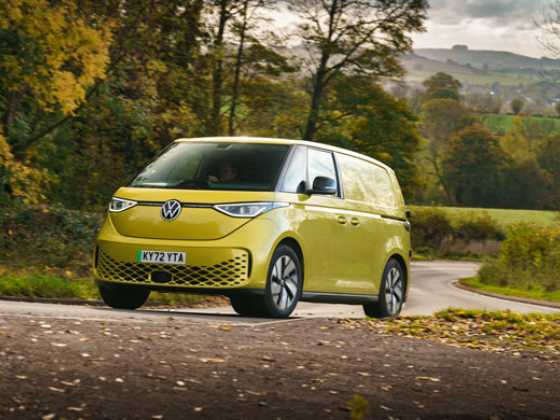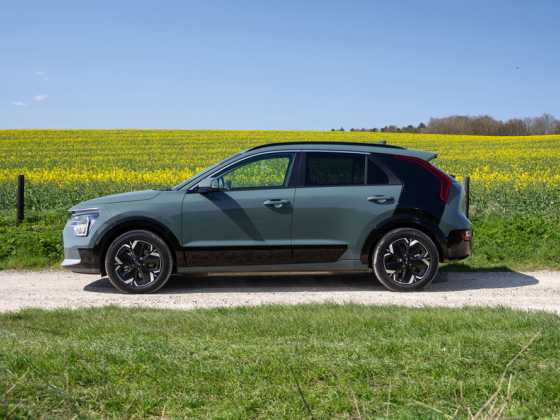A realistic electric option for van man
Roland Rendell climbs inside the Maxi Crew variant of the GreenFleet Award winning Renault Kangoo Z.E. and finds it to be roomy, rangey and responsive
 October 11th 2012 saw the Renault Kangoo Z.E. electric van crowned as the GreenFleet Electric Vehicle of the Year at Arsenal’s Emirates Stadium, and I thought it was only fitting to see what all the fuss is about. I was delighted to be offered a choice of variants – the Van, the Van Maxi or the Van Maxi Crew. I didn’t know such a line-up existed in full electric versions, so decided to try the biggest variant – the maxi crew van.
October 11th 2012 saw the Renault Kangoo Z.E. electric van crowned as the GreenFleet Electric Vehicle of the Year at Arsenal’s Emirates Stadium, and I thought it was only fitting to see what all the fuss is about. I was delighted to be offered a choice of variants – the Van, the Van Maxi or the Van Maxi Crew. I didn’t know such a line-up existed in full electric versions, so decided to try the biggest variant – the maxi crew van.
At first glance, it’s the sheer size of the thing that jumps out at you, and my first thought was: “Surely this cannot possibly operate on just electric?”
At 4.59m long, it’s longer than the standard van, but has five generous seats, plus room in the back for 1.33m (length at floor level) of load space with the seats up. The rear passenger bench is a 60/40 split-folding seat, so can help increase the load capacity further, but would subsequently reduce the number of crew it can carry. But, there’s certainly enough room for the tools and kit of a work crew.
The Z.E. badge on the back, together with the recharging flap on the front, are the only electric giveaways – most would fully expect it to be a diesel van. It has a kerbweight of 1,572kg, which is 162kg heavier than the standard model. 260kg of that is the lithium-ion 22kwh battery. The payload is an impressive 650kg, spread over its 3.08m wheelbase, and all of this weight is carried on 195/65 R15 low resistance tyres.
The other striking thing about this van is that it comes with full glazing (that’s brochure speak for windows all round), meaning it’s nice and bright inside, adding to the spacious feel. Driver and right-hand man (who is actually on your left) access the vehicle through normal doors, but the rest of the team have the luxury of sliding doors.
I always look forward to getting in and seeing how well I fit don’t fit. And, I must say, this is very impressive. I could be sporting a ‘60s Beehive and still have room for a Trilby. Unbelievable stuff. The roomy perception is aided by the way the roof arches out over the dashboard, with the glazing lending an almost bubble-like feel.
Looking around you have the typical high‑mounted gear selector. With this being electric, it’s an auto box, making it ideal for Van Man, especially around town. Above, it is the stereo system and climate control, and then recessed above that is the screen that houses the sat-nav. Through the steering wheel are the three dials I have come to recognise on the ‘electrified’ dashboard on all of the Renault Z.E. range. There’s a simple gauge on the left of the instrument panel that indicates the battery’s level of charge, speedo in the middle, and the one to the right shows how energy is being used. Blue is normal running, dark blue means regenerative charging is occurring and red means you’re driving like a loon.
As is usual, turn the key three quarters of the way around, the dashboard lights up and then wait. After a second or two, there’s the usual beep and you complete the turning cycle to fire her up. And – nothing. Not a sound. I’m used to it now though.
Rangey eco mode
I drive off in Eco Mode, selected via a button down to the right of the steering wheel, which Renault claim can improve range by as much as 10 per cent by restricting the motor’s performance. As with all EVs, the acceleration is great, is delivered by a 44kW motor, and gives you the equivalent of 59bhp and 167lb/ft of torque. Apparently, Renault research shows that most van drivers do less than 62 miles a day, so the 106 mile range should be plenty for daily use. It’s speed limited to 81mph.
Driving this van is simplicity itself – it handles as you’d expect, which means a fair amount of body roll through the corners and understeer if you go into bends too quickly. The ride is quite bouncy, but then, it was an empty van designed to carry up to 650kgs of cargo. The van also features regenerative braking, which is activated as soon as the driver lifts off the throttle. Regular readers remember what I’ve said before – driving an EV requires a slightly different approach and style, which can be a little bit alien at first. The subsequent engine braking is so aggressive that the van’s brake lights are activated automatically, which is good for the ‘tailgaters’ so common on the road these days.
Unlike internal combustion engines, electric vehicles are at their most efficient when being used in cities and in heavy traffic. At a standstill, an electric motor doesn’t use any energy, and constant low-speed running means improved efficiency. That means the Kangoo Z.E., in all its ‘general van’ guises, is probably best suited to ‘delivery van’ tasks. I have yet to see a delivery van that also carries five people, so the Maxi Crew model is more for your local maintenance type operations, where a company sends its workforce out locally.
Charging
The big question that the modern-day fleet manager wants answers to are How quick can I charge it and get it back out and operational? and How much does it cost? A standard daily battery charge takes between six and eight hours, when using the recommended wall‑box charge point. By scheduling charging at off-peak times, owners may be able to further reduce their vehicle running costs by taking advantage of cheaper energy tariffs, depending on their energy provider. Renault can provide an optional EVSE 10 Amp battery charging cable which can be used with a normal 240V domestic supply. This will allow the vehicle to recharge, but it will take longer (up to 11 hours for a full charge).
In the colder months, you can make sure it’s all nice and toasty, before you get in. There is a setting on the climate control function that allows you to programme the heater to come on at a set time while the vehicle is charging. This means it heats it nicely for you first thing, but most importantly, it does so drawing power from the electricity supply, not from the vehicle battery. So it doesn’t affect the charge at all. Smart thinking.
Cost
On the money side you are looking at £18,690 plus VAT, bringing it in at £22,428. However, earlier in 2012 the Government announced that the EV grants were to be extended to commercials, so the manufacturer’s OTR price, after the PIVG (Plug-In Van Grant) is £18,592. Although the cost price is cheaper than any of the Z.E.’s rivals (come to think of it… are there any?), as with all Renault’s EVs, you then have to add the battery hire cost. Over a three-year contract, you are looking at £60 per month if you do no more than 6,000 miles, and up to £87 per month for up to 15,000 miles a year.
In summary, the Renault Kangoo Maxi Crew van is more expensive up front than its diesel sibling, but the 20 per cent Plug-In Vehicle Grant discount takes the sting out of the tail. It could still make a lot of sense for businesses with daily operations that fall within the van’s range on a single charge (and its 650kg payload). And as most managers have an extremely good handle on how their vehicles are being used, this shouldn’t prove difficult to calculate.
Maintenance is also claimed to be 20 per cent lower than a standard van – no oil changes, no filters, no timing belts. But in your calculations, don’t forget the cost of installing a dedicated charging point. It’s surprisingly good to drive and really versatile, so the Kangoo Maxi Crew Z.E. could be a great inner city workhorse – as long as the maths works out.









